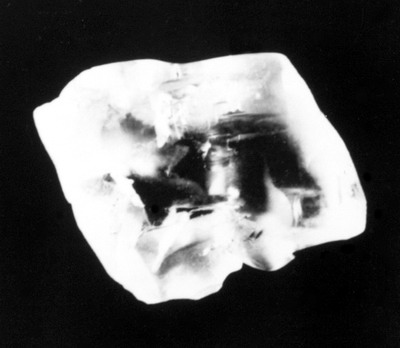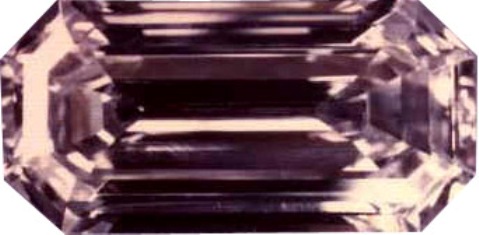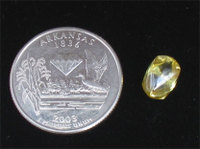The Uncle Sam Diamond
The Uncle Sam Diamond
The "Uncle Sam" diamond is the largest diamond ever found in the United States, weighing 40.23 carats and discovered in 1924, by Wesley Ole Ba sham in the Prairie Creek pipe mine, which later came to be known as the Crater of Diamonds Park, situated in Arkansas. The diamond gets its name from the nick name of the founder W.O. Ba sham, who was fondly referred to as Uncle Sam.
The Uncle Sam rough diamond crystal before cutting
Nature of the Uncle Sam diamond
The diamond is a 12.42-carat, emerald-cut stone with an unknown color and clarity grade. The website of the Crater of Diamonds State Park describes the diamond as a white diamond with a pink cast weighing 40.23 carats. The clarity of the diamond appears to be exceptional from the photographs of the diamond.
The Uncle Sam Diamond- After cutting
The slight pink tone of the diamond may be caused by slight plastic distortions in the crystal structure during its formation in the earth's mantle or subsequent rise to the earth's surface. The plastic ally deformed areas of the crystal change the absorption spectrum of the stone imparting the pink color. Thus the "Uncle Sam" diamond is most probably a Type Ila diamond, free of nitrogen and other impurities, but the color being caused by plastic deformation of the crystal.
Details of Diamond
The rough diamond weighing 40.23 carats was discovered in 1924 in the Prairie Creek Pipe mine at Arkansas, by a workman of the Arkansas Diamond Company, by the name of Wesley Ola Ba sham, whose nick name was Uncle Sam. The white rough diamond became the largest diamond ever discovered in the United States, and still holds that record.
The rough diamond was said to have been cut twice, and on the second occasion transformed into a perfect emerald-cut diamond weighing 12.42 carats. In 1971, the Uncle Sam diamond was reported to have been sold to an anonymous buyer for $ 150,000.
The Crater of Diamonds State park, located on State Highway 301, in Pike Country, southwest Arkansas, near Murfreesboro, is the only diamond mine in the world open to the public, where visitors are free to search for diamonds, and keep what they find. In other words the park is operating a "finders are keepers policy", a unique policy that has never been tried out before in any part of the world. This unique approach had proved to be a tremendous success, attracting over 60,000 visitors to the park every year, among whom the lucky ones discover on an average about 600 diamonds every year. This works out to an average of two diamonds each day.
The Crater of Diamonds State Park
The search area of the Crater of Diamonds State Park is a 36½ acre site, which is believed to be the eroded surface of a gem-bearing volcanic pipe known as the Prairie Creek Kimber lite pipe. These diamonds were formed millions or perhaps billions of years ago deep inside the earth's crust about 200 to 300 Km below the surface of the earth. The diamonds were subsequently brought to the surface of the earth by a violent volcanic eruption, estimated to have taken place about 100 million years ago. Test drilling at the crater has shown that the diamond bearing reserve or pipe is shaped like a martini glass.
Kimber lites which are a type of igneous rock are mica Periodontists that are found in pipes. They are rare occurrences in the catatonic (stable) areas of the earth's crust. The stable interiors of South Africa and Siberia have wide spread occurrences, but these pipes are also found in north America, Australia, Brazil and India. Not all Kimber lites contain diamonds. When diamonds do occur they constitute less than one part per million of the rock.
The diamonds found in the Crater of Diamonds site are generally less than one carat in size. Most of them are about the size of a match head or even smaller. The diamonds exist in different colors, however, the three most common colors found are white, brown and yellow, in that order. Diamonds of significantly larger sizes ranging from 2 to 40 carats have also been discovered, but their occurrence is rare. Diamonds found at the crater are typically smooth well rounded. They have a metallic luster and are generally translucent, i. e. light passes through them but you cannot see the other side.
Besides diamonds a range of other minerals are also found in this site such as quartz, amethyst, garnet, peridot, agate, jasper, calcite, Bartie. In all about 40 different rocks and minerals have been found in the site of the crater.
Discovery of Diamonds in The Park
Diamonds were first discovered in the area in 1906, by John Wesley Huddles ton who bought a farm on the site. But it is reported that two geologists had studied the site before 1906 with a view of identifying potential diamond-bearing sites, but could not find any diamonds. On August 8, 1906, while Huddles ton was spreading rock salt on his hog farm, he observed some shiny specks in the dirt around. His curiosity aroused, Huddles ton decided to probe the area that drew his attention, and retrieved two shining pebbles from the dirt. Having refused an offer of 50 cents for the two stones from a local bank cashier, Huddles ton dispatched the two stones to a gem expert in New York City, who confirmed that the two stones indeed were diamonds. One stone was a 3.0-carat white diamond, while the other was a 1.5-carat yellow diamond.
The Place where Uncle Sams's Diamond's found
News of the discovery of diamonds by Huddles ton sparked a diamond rush in Pike country. The farm next to Huddles ton's owned by Millard M. Maurine was also situated in the same gem-bearing crater. Diamond prospectors and fortune hunters rushed to the area, and within a short time the little town of Murfreesboro, assumed a boom town atmosphere reminiscent of the Kimberley township that developed in the cape region of South Africa during the South African diamond rush in the late 19th century. Huddles ton sold his farm to a Diamond Mining Company for $ 36,000, and the public were prohibited from mining in this area. Eventually the entire land covered by the crater became the property of two rival diamond mining companies, the Arkansas Diamond Mining Company and the Ozark Diamond Mines Corporation. It was during this period in 1924, that the largest diamond ever discovered in the United States, was found by a worker of the Arkansas Diamond Mining Company, which was subsequently named the "Uncle Sam" diamond. Over the next four decades the two companies engaged in sporadic mining activity, but operated under severe financial constraints, compounded by poor management, lawsuits and sabotage. Moreover the output of the mine was not sufficient to sustain the operations of the mine and to further expand mining operations. Thus the continued operation of the mine was not economical, and operations ceased at the mine by early 1950s.
Development of the Site
In 1952 the owners of the rival companies formed a partnership, not for further exploration of the mine, which they knew very well was not worthwhile pursuing, but to develop the site as a tourist attraction. They adopted the novel suggestion that the mine area be opened to the public to look for diamonds after paying a nominal fee, and keep what they find. The site was called the "Crater of Diamonds". A museum, gift shop and restaurant were also built and the site was promoted aggressively as a tourist attraction. The project turned out to be a modest success and several diamonds of significant sizes were discovered during this period. They are the 15.33-carat "Star of Arkansas" diamond discovered in 1956, that sparked a second diamond fever. Other diamonds include the 6.42-carat Gary Moore diamond discovered in 1960, and the 34.25-carat "Star of Murfreesboro" discovered in 1964.
In 1972 the Crater of Diamonds was purchased by the State of Arkansas, and converted into the Crater of Diamonds State Park. The new state administration of the park continued with the open policy of allowing the public to scout for diamonds for a fee, and keeping the find. Facilities provided for visitors were tremendously improved, and today the park has become one of the leading tourist attractions not only in the state but the entire country. Some of the facilities provided for visitors include camp sites, picnic sites, a cafe, standard pavilion that includes rest rooms, laundry, and gift shops, hiking trails, and interpretive programs for park visitors, and an aquatic play ground called the Diamond Springs. The parks interpretive programs and exhibits explain the site's geology and history and offer tips on recognizing diamonds in the rough. Diamond mining tools are available for rent or purchase. The Diamond Discovery Center provides free identification and certification of diamonds and minerals discovered.
Today the visitor turnout at the park is over 60,000 annually. Over 600 diamonds are discovered annually, which works out to an average of two diamonds per day. Since the discovery of diamonds in the area in 1906, over 70,000 diamonds have been unearthed, and since the establishment of the State owned park in 1972, over 25,000 diamonds have been discovered in the park. The largest diamond discovered since the crater became an Arkansas state park in 1972, was the 16.37-carat white diamond the "Amarillo Starlight" found in 1975 by W. W. Johnson, of Amarillo, Texas. About 15 other diamonds ranging in size from 3 carats to 9 carats, have also been discovered during this period.
In early 1990s Governor Bill Clinton of Arkansas signed a bill to authorize a lease for commercial exploration and mining at the park. A consortium of four mining companies undertook a preliminary exploratory survey to look into the possibilities of starting a full-scale deep mining operation. However, by 1994 it was clear that the returns from this exploratory operation were not encouraging, to make a full-scale mining operation viable. Consequently the companies decided to withdraw from the project. Further studies conducted in 1996, confirmed the results of the previous studies, and it appears that the Crater of Diamonds State Park is destined to maintain its status quo as a popular diamond "hunting" ground with all the thrill and adventure associated with it.




